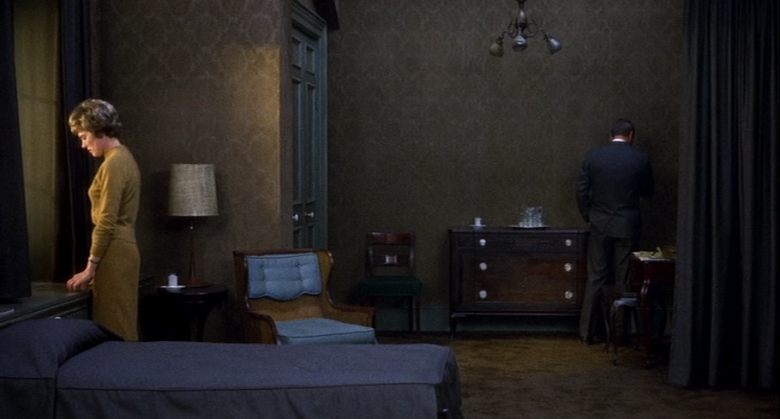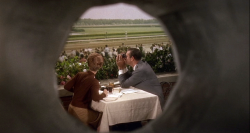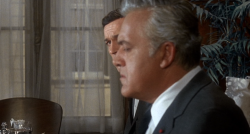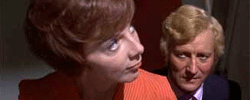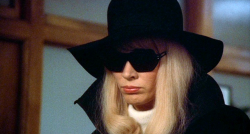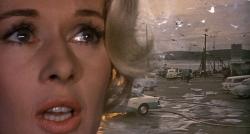Reviews
Alfred Hitchcock
USA, 1966
Credits
Review by Ian Johnston
Posted on 15 December 2011
Source Universal Studios DVD
Categories Late Hitchcock
Nowadays, Torn Curtain comes with as poor a reputation as any late Hitchcock: a dull sixties spy story which runs out of steam halfway through, undermined by technical imperfections (principally, poor process work) and miscast leads in the figures of Paul Newman and Julie Andrews who between themselves generate zero rapport on screen. In its day, there was the added, palpable disappointment on the part of Hitchcock’s supporters and exegetists that this should be Hitchcock’s fiftieth film; Robin Wood gave a perfect example of this when he added a new chapter to the second edition of his Hitchcock’s Films: “It is a pity that Torn Curtain is Hitchcock’s fiftieth film: everyone expected a major landmark, a culmination… . [It] is no culmination, being unsatisfactory, episodic, lacking the really strong center we have come to expect.” 1
Essentially, these criticisms do hold true, although on a personal note I’d add that I still much prefer Torn Curtain to the two films that follow, Topaz and Frenzy. It’s true that the film’s structure is a real problem, principally because the firm narrative line offered by Hitchcock’s original premise is never carried through. As he told Truffaut, “I got the idea from the disappearance of the two British diplomats, Burgess and MacLean, who deserted their country and went to Russia. I said to myself, ‘What did Mrs. MacLean think of the whole thing?’”2 So, the film starts off from the perspective of the Julie Andrews character, Sarah Louise Sherman. She’s the research assistant and fiancée to Newman’s Professor Michael Armstrong and has invited herself along to a scientific congress taking place on a cruise ship. We’re with her as she experiences confusion at Armstrong’s sudden cooling emotions, discovers his outright lies, and then follows him as he defects to East Germany bringing with him the secrets of an American missile research programme. This strand of the story then reaches its climax in a beautifully staged single-shot scene in Sarah’s East Berlin hotel room: she stands at the window in the left foreground with her back to the room, while Armstrong is stuck at the rear of the frame, as far from her and us as possible, twisting and turning nervously (Newman working away here at all the Method “business” that Hitchcock detested)—the whole scene gives perfect expression to Sarah’s sense of confusion, frustration, and personal betrayal.
But this is as far as the film goes with this. Hitchcock (as he directed scriptwriter Brian Moore) chose not to develop any further this theme of a woman confronted with her lover’s double betrayal of herself and of his country. Instead, the sixties spy narrative swings into action. Armstrong, it turns out, has merely pretended to defect in order to pick the brains of the East German Professor Lindt and win the secret of Lindt’s anti-missile missile for the West, and accordingly the film shifts its focus to Armstrong: his killing, in Torn Curtain’s most famous scene, of a Stasi agent, his winning of the formula, and his and Sarah’s escape. With what mystery there was to the story out of the way, Armstrong’s character becomes more straightforward and the story is propelled forward to its obvious conclusion. In the process, what ambiguities there are to Armstrong’s character - there’s an implication that this whole spy plot has been dreamt up by Armstrong to compensate for his career failure back home, and there’s the whole consideration of the way his bumbling amateurism leads to at least a handful of deaths and the disruption of an underground escape network - are glossed over. In this respect, the sombre promise of the opening credits, which contrast burning fire on one side of the screen with a series of anguished faces emerging from the swirling mist on the other, is not kept.
We can actually be grateful that the Sarah-themed narrative was not in the end pursued. Julie Andrews is inadequate in the role, too polite, calm, measured for a character that should be plumbing her emotional depths. (To be fair to Andrews, she is laden with some awful lines of dialogue.) It’s fascinating, then, to see how, in his stars’ first scene together, and in spite of inadequate performances, a lack of chemistry between the leads, and sub-standard writing, Hitchcock can still create an emotional charge out of his formal mastery of the scene. Sarah and Armstrong are canoodling under a blanket on the freezing cruise ship and Hitchcock simply restages the kind of love scene that he’s done so often before (Bergman and Grant in Notorious, Grant and Eve Marie Saint in North by Northwest, etc). The intensity of the close-ups generates a passion that is otherwise lacking in the performances and the script.
The pleasures of Torn Curtain reside in these Hitchcock “moments,” the smaller and larger set-pieces of cinematic choreography that run through the film and that doubtless held Hitchcock’s interest more than the mechanics of the plot or the travails of his lead characters. And there is no greater “moment” in the film that the scene of the killing of Gromek. Gromek has followed Armstrong to his Underground contact on a farm outside Berlin and confronts him, forcing the situation to the point where the farmer’s wife and Armstrong wordlessly conspire to murder him. The killing is long, slow, and difficult, as Gromek simply refuses to die. Even after he’s stabbed and whacked with a shovel, he’s still a strong enough adversary to both attempt escape through a window and to try strangling Armstrong, and he’s only defeated when he’s dragged slowly across the floor and gassed in the kitchen oven. It’s a deliberately savage scene - Hitchcock was aiming at some kind of sober realism - which the director analyses through his editing, breaking it down into a series of close-ups on objects, hands, and faces, shifting from high- to low-angle and back again, and ending on a grim overhead shot above the oven: Gromek’s head is inside, Armstrong and the woman pressed up against him, as Gromek’s hands release themselves from around Armstrong’s neck and twitch in the air in his death throes.
The force of this scene is made all the more intense by the fact that it plays out without any music score on the soundtrack. It’s a superbly effective choice on Hitchcock’s part, which may well have been decided by the post-production drama of Hitchcock’s break with Bernard Herrmann: dissatisfied with the score that Herrmann provided, Hitchcock either fired him or Herrmann quit. (By all accounts, they never even met again.) 3 You can find Herrmann-scored scenes from Torn Curtain on both the Universal DVD and YouTube, but to be honest I think Hitchcock was right. Herrmann’s score seems derivative and unimpressive, very far from the essential contribution he made to Hitchcock before (Vertigo and Marnie are impossible to imagine without Herrmann’s music).
In fact, the rather anonymous score that Herrmann’s replacement John Addison provided is more in keeping with Torn Curtain’s brand of slightly dour realism, most obviously evidenced in the drab colour scheme that is only occasionally enlivened by little splashes of red, just as the less-than-compulsive spy narrative is compensated for by some fine illustrations of Hitchcock’s principles of suspense: the escape on a fake bus to Berlin; Sarah and Armstrong’s entrapment in a theatre auditorium that is, unknown to them, filling up with security police behind their backs; even the small post office scene of their waiting for their Underground contact to appear after we’ve seen a security guard notice them and go off, presumably to call the authorities. By the time we reach the final scene of the film, we know well enough to ignore the silly humour (this aspect gets worse in the last part of the film) and to let us be guided by the Master’s hand. Here, a dolly forward to close-up on the blanket that drapes and conceals from view Sarah and Armstrong is an explicit rhyme back to their first scene together, a final assertion that the considerable pleasures of Torn Curtain are to be found in its formal design rather than in story or character.
More Late Hitchcock
We don’t do comments anymore, but you may contact us here or find us on Twitter or Facebook.



